

Birthday Cakes: History & Recipes
By Mary Gage & James Gage
Copyright © 2012. All Rights Reserved.
No portion of this article may be republished without written permission from the authors.
Please feel free to link to this webpage.
History and Origins of Birthday Cakes & Candles
The tradition of celebrating a person’s birthday with a birthday cake and lit candles originated in 18th century Germany. In 1746, Count Ludwig von Zinzendorf of Marienborn Germany celebrated his birthday. Andrew Frey, one of the guests, gave a detailed account of the party:
“… the Houses to be illuminated on that day, which was accordingly done. They fetch Waggons full of Boughs, and with them covered the whole inside of the Count’s Hall, which is a hundred feet long, and forty wide … that it looked like an Arbour, and also hung up three brass Chandeliers, each of seven candles. In it also are four Pillars which were hung full of Lights spirally disposed. Wooden Letters above two Feet long were made to form the Name of LUDWIG VON ZINZENDORF, and these being gilded with Gold, were fixed to the Wall amidst a Blaze of Lights. The seats were covered with fine Linen set of with very sightly Ribbons. A Table also was made, representing the initial Letters of the Name of the Person who was the Subject of the Festival; there was a Cake as large as any Oven could be found to bake it, and Holes made in the Cake according to the Years of the Person’s Age, every one having a Candle stuck into it, and one in the Middle; the Outside of the Court was adorned with Festoons and foliage …” [Frey, 1753: 15]
In Germany, children’s as well adults’ birthdays were also celebrated with birthday cakes. In the 1800 London edition of Christian Salzmann’s book Gymnastics for Youth (translated from German) we find the following brief passage “before his sixth birthday cake is put in the oven.”
How and when the tradition of a birthday cake spread to the rest of Europe is unclear. There are very few references to birthday cakes prior to 1850. In a widely circulated article published in 1843, Mrs. Abell writes that the exiled Napoleon Bonaparte was given on his birthday from an English friend a “cake ornamented with a large eagle”. In a fictional children’s story published in 1834 we find the following dialog, “ `On the morning of the 17th of May,’ (continues his papa,) `the day on which he completed his ninth year, he said to his mother, `Mamma, I should like to have a birthday cake.” (Anon 1834, 176)
Prior to 1850 in United States, the observance of birthdays was not a universal tradition as it is today. The newspaper Richmond Whig observed in 1865 “Mothers who have a dozen little ones to care [for] are apt to neglect birthdays; they come too often.” The Ladies Repository in 1871 noted that “Americans make too little account of anniversary occasions” and “rush through life with such velocity as to find little time to lay garlands on the milestones [of life].” (p.43) The Ladies Repository continues by pointing out that some Americans in adhering to the values of their Puritan ancestors have taken the early Protestant prohibition against religious festivals too far by rejecting family centered events like birthdays. It is clear there were both practical as well cultural and ideological reasons for not celebrating birthdays. It is likely that economic reasons also played a role especially for large working class families.
Interestingly, both the Richmond Whig and Ladies Repository articles made a passionate argument for the universal adoption of birthdays for children. The writers of these two articles were part of a larger social trend which emphasized children’s birthdays. This trend began in the 1850’s. (The evidence for an emerging trend can be seen in dramatic increase in the number of references in the period literature to birthdays.) Many of these celebrations include a birthday cake. The Americans were well aware of the German birthday festivals and detailed accounts were published in various publications (cites). It is likely they adopted the concept of a special cake for birthdays from the Germans. Although there was a strong emphasis on children’s birthdays, adult’s birthdays were also being celebrated as well.
The Americans were slow to adopt the German tradition of lighting a candle for each year of a person’s life. The earliest references in American newspapers and journals to the birthday candle tradition do not appear until the early 1870’s. The Ladies Repository article (1871) is one of the earliest American publications to promote the German candle tradition in America. It states “The huge, decorated, birthday cake is placed in the center-table, and around it are ranged lighted candles, graduate in length and number by the age of the child. As the first slender taper, signaling babehood, goes out, the assembled family and guests united in singing one verse of an appropriate hymn, and thus they go in order to the last, each year expiring in music. What could make a sweeter, holier impression on the heart of a child?” The singing of verses from hymns never gained momentum but the singing of a song after the candles have been lit has become a part of the tradition.
The tradition of the birthday boy or girl blowing out the candles (rather than letting them burn down) can be traced back to the 1880’s. In Switzerland during the year 1881, folklore researchers collected the following “superstition” from the Swiss middle class, “A birthday-cake must have lighted candles arranged around it, one candle for each year of life. Before the cake is eaten the person whose birthday it is should blow out the candles one after another.” [anon 1883, 380-381) There is no mention of making a wish. A different version of this tradition emerged in America during the early 1880’s. In New York state, the Watertown Daily News reported that around the birthday cake, “were placed 10 candles, 9 of which were kept burning, and one representing the year begun, and not passed, [remained] unlit. The youthful host selected nine of his friends to serve as well-wishes, each to make one wish, and to blow out one candle …” (6-2- 1882) The nine well-wishes spoke their good wishes out loud before blowing out the candle. It should be noted that the birthday boy did not blow out any of the candles. In Michigan, the practice of adding an extra “growing candle” was also observed. Unlike New York, the extra candle was lit. Like the New Yorkers, certain guests were asked to make a wish for the birthday person and blow out a candle. (Michigan Farmer 11-18-1884) This tradition of having the guest blow out the candles continued into the first decade of the 20th century. The book Correct Social Usage (1909) written in New York, recommend this practice but instructs that guests to keep their wishes a secret.
One of the earliest references in the United States to the birthday girl or boy blowing out all the candles (rather than the guests) is found in the March 1909 edition of St. Nicholas, a children’s magazine. Three candles were stuck into the frosting of the cake and lit. Then, “Bab cut a piece of cake for Ned, and Ted, and for Nursie, and then she blew out the candles and so her beautiful part was over.” (p.456) At some point in the 20th century, it became a tradition that your birthday wish only came true if the birthday boy or girl successfully blew out all the candles in a single breath.
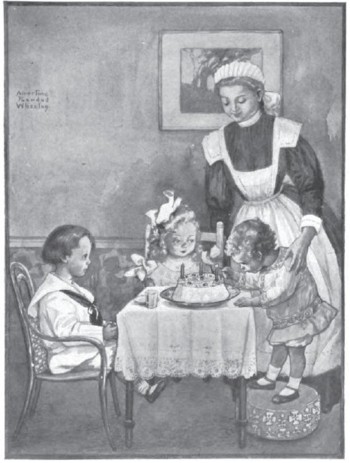
Birthday Party from St. Nicholas magazine (1909)
In America, children’s birthday parties had become socially fashionable by the 1880’s. The Michigan Farmer (1884) writes “In this city birthday parties are very much in the fashion. Where the little ones attend the kindergarten, a birthday serves as a semi-holiday.” (p.8) During this decade, it was common to see descriptions of children’s birthday parties appearing in the social columns of the local newspaper. Some of the longer accounts even include a list of guests in attendance. (ex. Watertown Daily News 6-2-1882; New Haven Register 11-10-1888 and 10-24-1888)
Birthday’s had been being celebrated with Birthday Cakes for about fifty years when Mrs. Owens published her cook book in Chicago, Illinois in 1899. Yet she felt it her duty to explain how a birthday celebration in particular the part with the cake should be handled.
She explained a large cake was to be baked in the “dripping pan and heavily frosted.” When the frosting was partially dried “mark it off in small squares and put half an English walnut meat on each.” The next step was to cut a narrow “paste-board” [cardboard] frame to go around the edge. Small holes were cut in the paste-board to hold the candles. To dress up the frame, fancy colored paper was added. Then she explained how it was to be served. “The lights in the room should be put out and the cake brought in with candles lit and placed before the person whose natal day is being celebrated and he should cut and distribute it.” (p.462)
Candle Holders
The late 19th century birthday candles were made from paraffin wax which was safe to eat, so it was not a problem if some of it dripped on the frosting. The Successful American recommended sticking the candles in the frosting and argued, “The delicate paraffine candles having neither grease nor disagreeable odor, the cake has received no injury whatever in having thus been utilized as a candelabrum” (p.80) Not everyone agreed with this sentiment. The dripping wax marred the appearance of the cake and therefore various handle holders were developed for birthday cakes to avoid this. Beginning in the 1880’s, small candle holders in the shape of roses and rosebuds which were attached to the cake became available for purchase. They came in different colors like pink and white. (Boston Herald 7-26-1888; Evening Tribune [NY] 2-10-1902; Evening Journal [NJ] 6-24-1904) The main purpose of these candle holders was to provide festive decoration for the cake and they had the added benefit of collecting the dripping wax.
The 1890’s saw the introduction of various candle holders that went around the outside of the cake. For example in 1891, the book Polite Society at Home and Abroad described, “A pretty little device is the birthday cake, around the edge of which is fitted a rim of tin which are placed wax candles.” (p.235) In 1899, Mrs. Owens provided instructions for making the candle holders. The cake was square or rectangular and she instructed you to cut a narrow “paste-board” [cardboard] frame to go around the edge. Small holes were cut in the paste-board to hold the candles (p.462). By the 1910’s, commercially made “birthday cake rings” were being marketed. These were painted wooden rings with holes drilled in them for the candles that were placed around the bottom of the cake. (Boston Cooking School Magazine May 1914)
These rings could be made as a do-it-yourself home projects. The School Arts Magazine (Oct 1914) gave the following instructions: “It consists of a circular ring of wood, about a foot in diameter and an inch wide by a little less in thickness, in sections. Holes are bored in the ring at equal intervals, to hold birthday candles. This ring is placed on a table, the birthday cake in the center.” Popular Mechanics (May 1915) provided instructions for a slightly different version. “Birthday-cake boards arranged to accommodate any number of candles up to 26, are made of hard wood finished in its natural color. These boards are circular in shape, and around the outer margin is provided a series of holes in which the candles are held, while the cake itself is placed in the middle of the tray.” (p.706) These candle ring holders were being used into the 1930’s. Popular Mechanics (May 1936) gave instructions for a more elaborate cake board with attached ring.
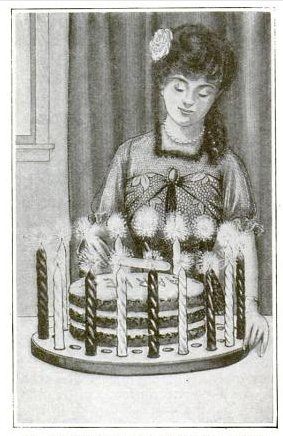
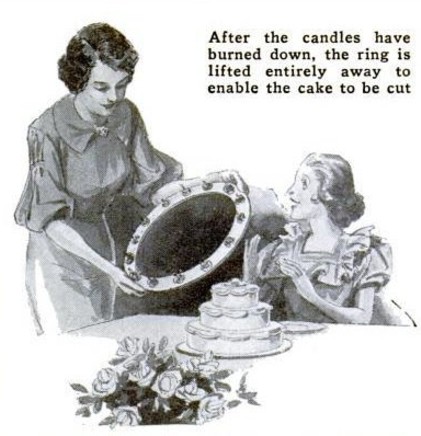
Left - Cake board with holes drilled around edge for candles Popular Mechanics (May 1915)
Right - Cake ring with holes drilled around the edge for candles Popular Mechanics (May 1936)
There were a number of candle holder options available by the 1910’s. The National Baker, a trade journal for the commercial bakers writes, “There are various kinds of candle-holders for birthday cakes, those shaped like a star, a ring or a daisy, and selling at one or two dollars a hundred. There are also dove candle-holders and rosebud holders.” (June 1913, p.58)
Birthday Parties & Children’s Parties
1871
From William Henry and His Friends, 1871 (published in Boston)
This is an excerpt from a popular children’s book:
“We had pretty stirring times at the Farm for a few days. Stirring, indeed! Hannah Jane stirred up about every kind of cake in the receipt-book. The birthday-cake itself, I remember, was baked in a four-quart iron basin (the brown bread iron basin), and was frosted and adorned by Matilda. There wasn’t room for his whole name; but she wrote ‘S Banner’ on top with red sugar-mites.” (p.20)
1884
Boston Herald Newspaper (12-18-1884)
Whittier’s Birthday
“John G. Whittier, the poet of New England, observed his 77th birthday, at his winter home at Oak Knoll, Danvers, yesterday, and received calls of congratulation from quite a number of friends. Among those who called were Mr. Coffin of Lynn, Albert G. Brown, of Salem and Dr. Goldsmith, of Danvers asylum. Mr. Whittier received his guests with the Misses Johnson and Mrs. Woodman, cousins of the poet. Among the pleasant tokens of remembrance were a fine birthday cake from Mr. Coffin, with the inscription ‘J. G. W., Dec. 17, 1807- 1884.’ This was placed on the lunch table, surrounded with 77 colored candles, a basket of 77 rare roses from the girls’ high school, [B]oston; a second cake from his cousins, Misses Johnson and Mrs. Woodman, with the quotation from Mr. Whittier’s poem, ‘My Psalm,’ ‘My hearts is young again.’ Upward of 40 letters from friends abroad were received. Mr. Whittier is quite smart for a man of his years.”
The idea of a person’s name on a birthday cake shows up sporadically. It was used in London circa 1850, “a birthday cake, ornamented with flowers and fruit, and the words, ‘Vivat Gertrude,’ in the centre, all made in sugar,”. (anon 1850, 87) In New England it was used on a cake for a fictional character in a children’s book and on Mr. Whittier’s birthday cake. These early uses of the person’s name took many years to catch on. It did not become fashionable in New England until the 1940’s when it shows up in cook books encouraging the idea.
1900
Boston Cooking School Magazine, June-July 1900, vol.V, no.1, p.38
Query 354 – From Mrs. A.WB., Everett, MA
“Kindly give simple but novel menu for a children’s party to be held in the latter part of May or first of June.”
Response:
Menu, Children’s Party
Sugared Strawberries and Oranges in Orange Baskets
Chicken BrothPretzels
Broiled Beef TenderloinPotato Balls
Maitre D’Hotel Butter
Asparagus Tips on Bits of Toast
Lettuce Salad
Entire-Wheat-Bread Sandwiches
Ice-Cream in Meringues or Paper Baskets
Lady-Finger Sandwiches or Cake [Frosted] with Lighted Candles
Jack Horner Pie
The editor of the magazine chose not to give a “novel” menu and instead as she explained it, give a menu that included foods the children were accustomed to. She felt it would be healthier for the children as the meat and vegetables listed would probably be their dinner. The editor explained the Lady Finger Sandwiches, a simple but fancy cake decoration, and the Jack Horner Pie.
Lady Finger Sandwiches: “lightly spread fresh fingers with strawberry preserves and press together in pairs.”
Cake: “If a plain cake, iced and decorated with candles, be desired, very pretty candle-holders may be purchased for a few cents a dozen.”
Jack Horner Pie: “After the feast is ended and the finger bowls passed, the Jack Horner pie may be brought in and set in the place of the floral decoration. This pie consists of a large pan, covered daintily with tissue paper, and filled with pretty trifles [party favors] corresponding in number to the guests; to these trifles narrow ribbons are attached, the ends of which are passed to the guests; the top is covered with paper, thus concealing all that is within. At a given signal each child pulls its ribbon and captures a little souvenir.”
The menu included cake in the form of Lady Finger sandwiches or frosted cake decorated with candles set in “pretty candle-holders”. Candles were becoming the favored way to decorate a cake. Ice cream in meringue cups accompanied the cake. Party favors pulled from the Jack Horner Pie concluded the party. These three items became the basis for the common children’s birthday party in the 1900’s.
New England’s Evolution of the Birthday Cake
As followed through the numerous editions of the Boston Cooking School Cook Book and Magazine.
1906
The earliest illustration of a birthday cake was for a child’s birthday cake in the Boston Cooking School Magazine issue March 1906 vol. X, no. 8. The cake was a sponge cake baked in an angel-cake pan. An angel-cake pan is a round pan with tall slanting sides. The cake was turned out of the pan upside down on to a silver platter, so that the cake was wider at the base than at the top. The somewhat narrower top had a flat circular surface. Boiled frosting was used to cover the cake. The frosting was placed on the cake and smooth out to a flat finish. (p.388-9)
The decoration consisted of two parts. The first part was the piped frosting. Around the rim, frosting was piped in a long, single strand with a ribbed pattern from a pastry tube. This framed the top. The same ribbed strand was then placed in a vertical position with a curled loop at the bottom. The vertical strands were spaced out around the outward slanting sides of the cake. The second part was the candles. The candles were placed in pretty, rose-bud candleholders in a ring around the top of the cake. The candles were the decoration and took up the whole top. Illustration page 381
The sponge cake became the favored child’s birthday cake. This separated it from the butter based fruit cake which also became a favored cake for use as a birthday cake presumably for adults.
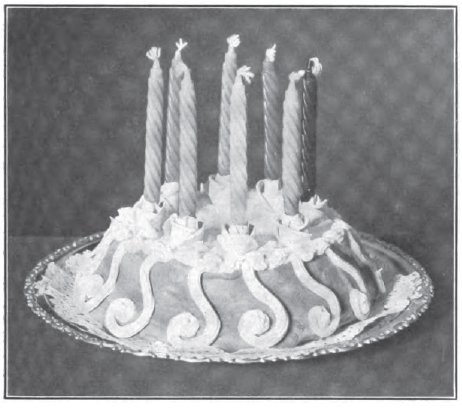 |
Decorated cake with piped frosting & rosebud candle holders served on a silver platter.
Boston Cooking School Magazine (Mar 1906)
1910
The 1910 edition of the Boston Cooking School Cook Book had a recipe named “Birthday Cake”. It was a butter based cake with fruit – butter, brown sugar, egg yolks, flour, baking powder, orange extract, vanilla extract, sherry, raisins, walnuts, currants, candied orange peel, and 2 egg whites.
In its day this was a special type of cake. There were no seedless grapes to make raisins. Raisins had seeds which had to be removed, a lot of work. The raisins should be cut in half, soaked in hot water to soften then the seeds were removed one at a time. The eggs were separated, the yolks mixed in with the batter and the whites beaten stiff by hand. The cake was baked in an Angel-Cake pan, the favored shape for many decorated cakes including the birthday cake. (p.514)
This edition, had two illustrations of decorated cakes, one for a Valentine Day’s cake and another for what appears to be a Christmas Cake. The Valentine Day’s cake was baked in a circular tube pan commonly used today for chiffon cakes. The purpose of the tube pan was to have a hollow shaft in the middle of the cake in which to put fresh flowers as part of the decoration. The other part of the decoration was created by piped frosted designs of hearts on the top ring of the cake and on the sides. The Christmas Cake was baked in Angel Cake pan so that it had a solid top. Another way was used to decorate this holiday cake. A ring of candles was placed on top. An overlapping ring of holly leaves was placed around the bottom. Plus, closely spaced piped strands of decorative frosting on the sides. It was very fancy. There was no illustration for the Birthday Cake.
1914
The Boston Cooking School Magazine supplemented additions to recipes found in the school’s cook book. In 1914 a newer version of the Birthday Cake was showcased in the magazine (May 1914, vol. XVIII, no. 10) exhibiting a few changes. The Hickory Nut Cake was chosen. It was a slightly different version of the older butter based fruit cake. The Hickory Nut Cake was baked in a circular tube pan. It was placed on a decorated ceramic plate. The cake had a flat, smooth covering of frosting. On that was placed single realistic flowers on long stems with leaves. These were put on the top and on the sides. Surrounding the decorated cake and plate was a separate “Hand Painted Ring To Hold Birthday Candles”. The candles were alternated by a plain candle (short) and twisted candle (tall). The candles came in assorted colors. The twisted candles were slightly taller than the top of the cake, thus obscuring the decorations on the cake.
This version of the cake maintained the special quality but lacks the elegance of the earlier cake served on a silver platter. It brings the Birthday Cake into the realm of the middleclass family. The hand painted candleholder ring is a simple wooden ring with simple/plain painted dots and ovals. It is an inexpensive mass produced product. In reality it was an upgraded version of the 1899 homemade paste-board frame to hold the candles placed around the top edge of cake. (p.776)
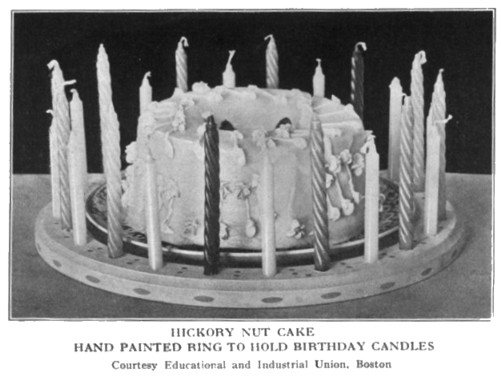 |
A simpler version of the birthday cake with a wooden candle ring.
Boston Cooking School Magazine (May 1914)
1933
From 1910 through 1926 there were no changes in the Boston Cooking School Cook Book. The next book that I own is the 1933 edition which has a major change. It contains the 1st generation of the modern decoration of the Birthday Cake.
There were also a few minor changes. The flavor of the cake was changed to orange with the addition of orange extract otherwise it remained the same butter based fruit cake. It was baked in an Angel Cake pan with a solid flat top.
A new type of candleholder was introduced. It was a large plain plate (ceramic or wooden?) with small holes around its outer edge to hold the candles. The cake was set directly on it. This new version of the candle-ring replaced the narrow hand painted wooden ring.
The decoration was upgraded to spray’s of multiple flowers on stems with leaves. Two sprays of flowers were put on top and several around the sides. To set the top off from the sides a fancy piped border was added around the top edge of the cake. To delineate the cake from the plate, flower-heads were closely placed around the bottom edge of the cake. The borders framed the flower designs.
The frame extended to the new candleholder with much smaller holes than it predecessor. It held very short candles. In this new version the candles were used to illuminate the fancier decorations.
The major change was the wording “Happy Birthday” written on top. Although it did not immediately take hold, this proved to be revolutionary (p.684).
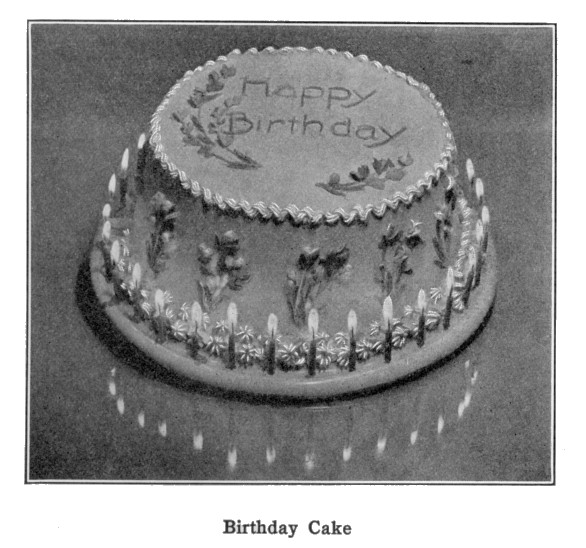 |
An early example of the words “Happy Birthday” appearing on a cake.
Boston Cooking School Cookbook 1933, p.684
1936
In 1936 a far simpler decorated cake was introduced for the child’s birthday cake, “Cream Sponge for a Birthday with Bright Wooden Birds Feeding on Tiny Candy ‘Seeds’.” The photograph shows a circular cake with straight sides and flat top with frosting that has a flat smooth finish. There was no frosted decoration on top. Around the sides there was a single line of flower-heads that matched the designs on the cake platter. The cake platter was much larger than the cake permitting the decorative designs to show. It was part of the presentation. There is no longer a candle ring it was replaced by small brightly colored wooden birds arranged like a small flock of birds feeding on seeds on the ground. It was cute for a child’s birthday decoration. (Boston Cooking School Cook Book 1936, 652)
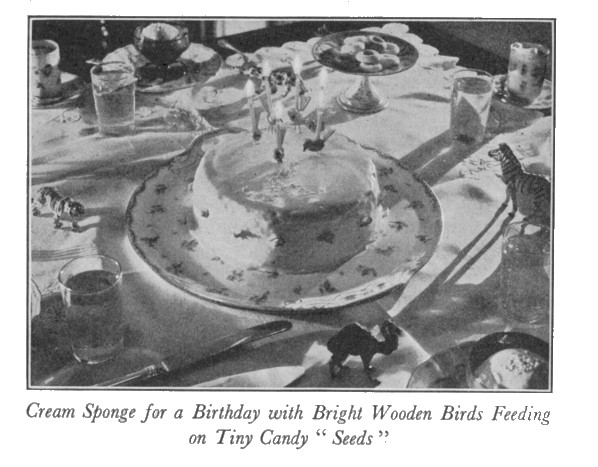 |
A simple birthday cake with wooden bird candle holders. Note the other animals on the table.
Boston Cooking School Cookbook 1933, p.652
In this version, the child’s cake is simplified. The concept of animation, birds pecking at seeds was introduced. Having birds arranged in a random order made it easier to set up the correct number of candles to correspond to the child’s age. The near absence of decoration made the cake a simple affair to make. It appears to be in response to the large families who did not have the means to give each child a birthday cake, thus offering a solution.
In this same edition, the regular birthday cake was also shown. It was the same as in the 1933 edition but it was renamed. The new name “Birthday Fruit Cake” better reflects the actual type of cake. There is also an additional notation regarding the decorations. “Decorate, using pastry tube, with Ornamental Frosting (p.682) or sweetened whipped cream, tinted as desired with vegetable coloring.” The photograph was the same one used in the earlier edition showing the ring of candles was still in fashion for adult birthday cakes (p.665).
Sweetened whipped cream could not be shaped to produce ornamental designs, thus some birthday cakes had no decoration. This was confirmed by a friend who grew up in the 1950’s who told me her mother did not decorate their birthday cakes for many years until she learned the art of decorating.
1947
Eleven years later the 1947 edition of the Boston Cooking School Cook Book, shows a wider variety of decorative ideas otherwise nothing changed. “Follow any of the designs shown or copy real flowers or other designs. For a child’s cake, dip animal crackers in frosting or melted sweet chocolate and press into frosting on sides of cake. Set on board fitted with birthday candles [see 1933 edition] or arrange candleholders symmetrically on cake. For further instructions, see p. 689.” (p.686-7) Wooden birds are shown arranged in a small tight flock.
New to this time period was the person’s name or initials in ornamental frosting on top of the cake. The person’s name was not used with the words “Happy Birthday” it was one or the other.
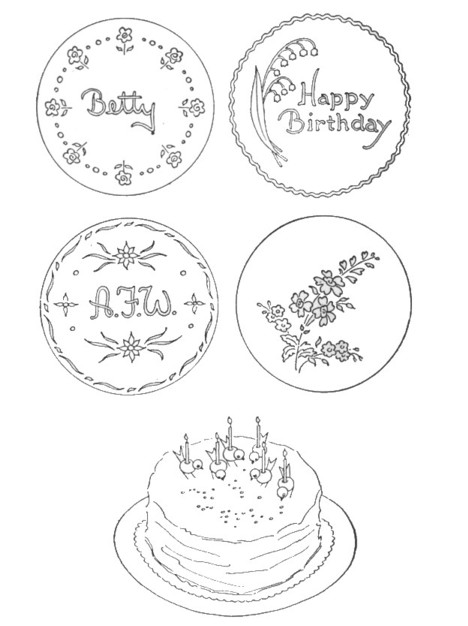 |
Various birthday cake decorating ideas.
Boston Cooking School Cookbook 1947, p.686-87
On page 689 there was an interesting note on frosting cakes:
“TO FROST CAKES. Spread on cake with a spoon or spatula. When frosting a whole cake, frost sides first, then put remainder on top and spread. Do not try to make too smooth a surface. A slightly uneven surface has a pleasantly ‘homemade’ look and is much more attractive than one which is the result of much fussy work.”
The cook book is being marketed to a society recovering and emerging from a World War. This was the beginning of the baby boom, hence large families again. The war was over but work was scarce. Women were making their family’s birthday cakes. Telling them the “homemade look” was fashionable made making and decorating your own cake, socially acceptable.
1959
The “Birthday Fruit Cake” is still the recipe. Under Frostings there is a short section entitled “Birthday Cakes”. It starts, “Candles are the traditional decoration – and the simplest.” (p.462) Candles by then were only being used on birthday cakes. But true, they were traditional.
1965
The Cakes chapter introduced a section on “Serving Cake” where it made suggestions as to what kind of cake to serve.
“For special occasions. Birthdays: Make any layer cake or Birthday Fruit Cake.” (p.457)
This is the first time the layer cake is mentioned as a birthday cake. The layer cake in this edition was put first and the fruit cake second. That suggests the layer cake had become the favored kind of cake for birthdays.
How did the Boston Cooking School ideas influence New Englanders?
1947
In 1947, Secrets of New England Cooking was published. In it was a recipe for Roddy’s Birthday Cake. The recipe was for a sponge cake flavored by orange juice, as its liquid, and baked in layer pans. “Turn into two lightly buttered eight-inch layer-cake tins”. (p.237) It had Orange Filling between the layers and was covered with Orange Frosting.
This cake shows a shift toward layer cakes for the birthday cake. It shows new ideas and changes took place in society prior to those ideas making it into cook books. It is not until 1965, that layer cakes are listed as the favored birthday cake.
1950’s (from the author’s personal experiences)
As a child, I was one of eight children, growing up on the northshore of Boston. In the 1950’s and into the 60’s our family celebrated all ten birthdays (parents & kids) with a birthday cake. Our traditional birthday cakes were a white (vanilla flavored), double layer cake with frosting between the layers and covered with frosting on the outside. The frosting was a butter cream frosting. Simple designs, homemade creations made using the pastry tube and tips. My mother owned one cook book, the Basic Cook Book that lacked frosting designs to copy. The cake was finished with tinted frosting used to write “Happy Birthday” and the “name” of the person. Candles were placed directly in the frosting. Candleholders were more than my parents could afford. The lights were turned off and the candles lit in the pantry, the cake then made its grand entrance. After the birthday person made a wish, then blew the candles out everyone joined in removing the candles and licking the frosting off the ends. It was the only birthday cake I ever knew.
Ice cream always accompanied the birthday cake. If your parents could afford a real birthday party with invited friends, a party favor was included. The party favor was a crepe-paper covered paper tube with tab to pull it open. Inside was a small trinket, the party favor. This was the modern version of the Jack Horner Pie.
Where the idea of a double layer white cake used for a birthday cake came from is unknown. However, in the early 1960’s it was the favored bakery birthday cake in my area. I worked in a small bakery during my high school years.
1978
Favorite Recipes from the Diary of a New England Cook has short writes ups with each recipe. “Today is Larry’s birthday. This calls for a special cake reserved for birthdays. It is not the easiest cake and one must follow the directions carefully. It may be cut in half [horizontally] and filled with any favorite filling, or cut into thirds to make an even higher cake. All of my family prefer whipped cream, tinted their favorite color, and decorated with candles.” (p.34)
The cake was an Angel Food Cake flavored with orange extract. It is light, similar to the child’s sponge cake. It was often cut into layers to make it higher, like a layer cake. The frosting was tinted whipped cream. Decoration was candles placed directly in the frosting. It was embellished with “a small bouquet of flowers placed in center of cake is very pretty.”
This cake embodies every idea found in New England birthday cakes. Orange flavoring was introduced in the Birthday Fruit Cake. Whipped cream as frosting was introduced by local women. Sponge cake type cakes were the common child’s birthday cakes. Candles a birthday tradition were placed directly in the frosting as a means to hold them upright. This was a result of the lower class who could not afford candle holders. The lack of ornamented frosted designs was also common on some family birthday cakes. It showed up on the child’s birthday cake in the 1936. My friend, Linda said her mother for many years did not include ornamented frosted designs in the 1950’s.
So what is a traditional birthday cake? It is a frosted cake served with candles. It can be layered or single; low or high; flavored with vanilla, chocolate, or orange; frosted, with or without decorations; but always has candles. Traditional birthday cakes are a particular cake repeatedly made within a family over many generations. Here is the recipe from the Jewelltown Farm in South Hampton, New Hampshire, Post Office, Amesbury, Massachusetts.
A bit of trivia, for New Englanders growing up reading Lil’ Abner. Jewelltown was the summer home of Al Capp, the cartoonist.
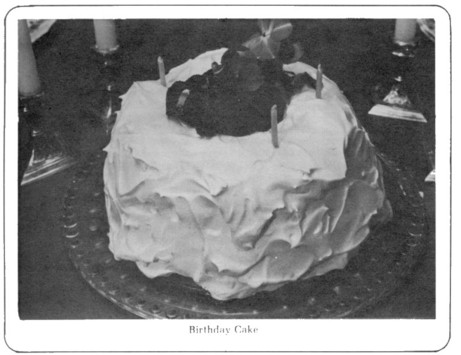 |
Birthday cake with whip cream frosting.
Favorite Recipes from the Diary of a New England Cook (1978) p.34
Birthday Cake
(from Favorite Recipes from the Diary of a New England Cook by Corinne Morse, Jewelltown Farm)
1 ½ cups sugar ½ teaspoon vanilla
2/3 cups water 6 egg yolks
1 cup egg whites 2/3 cups cake flour
½ teaspoon salt ½ teaspoon orange extract
1 teaspoon cream of tartar ½ cup cake flour
Cook sugar and water without stirring, to thread stage or 234 degrees
Beat egg whites until foamy, add salt and cream of tartar and beat until stiff but not dry.
Gradually pour hot syrup over egg whites, beating constantly until cool
Be sure mixture is cool
Divide into two parts – 2/3 in one bowl and 1/3 in second bowl
Into the larger part – fold 1/2 cup flour and the vanilla
Into the smaller part – add well beaten egg yolks, then fold in 2/3 cup flour and orange extract
Spoon batters alternate into a 10 inch ungreased angel cake pan
Bake at 325 degrees for one hour. Invert to cool
When cool, remove from pan and decorate with favorite frosting and candles
A small bouquet of flowers placed in center of cake is very pretty
Birthday Cake (Sponge Cake for two layers) - Easier Recipe
6 egg yolks (large egg size)
1/3 cup water
1½ cup sugar
1 teaspoon vanilla
Beat egg yolks until thick and lemon-colored
Add water
Gradually beat in sugar, then add vanilla
1½ cup white flour
¼ teaspoon salt
Sift flour and salt
Fold into egg yolk mixture a little at a time
6 egg whites
3/4 teaspoon cream of tartar
Whip egg whites with cream of tartar until stiff peaks form
Gently and gradually fold beaten egg whites into egg yolk and flour mixture
Bake in two, 9 inch diameter by 2 inch high round cake pans. (If using 9 inch diameter by 1 1/2 inch high pans, you will need three pans.) Do not grease. Cut a round sheet of parchment or wax paper the size of the cake pan and place on bottom. Pour cake batter evenly into each pan. Bake 350 degree about 25 -30 minutes. Invert pan on rack and let cool before removing cake. Cake will shrink a little.
Birthday Fruit Cake
(from Boston Cooking School Cook Book 1936, p.665)
½ cup butter ½ cup seeded raisins, cut in pieces
1 ¼ cups brown sugar ½ cup walnut meats, cut in pieces
2 egg yolks, slightly beaten 1/3 cup currants
2/3 cup milk 2 tablespoons candied orange peel, finely cut
2 ¼ cups flour 2 egg whites, stiffly beaten
3 ½ teaspoons baking powder
1 teaspoon orange extract
1teaspoon vanilla
Cream butter, cream in sugar, add yolks. Mix and sift flour and baking powder. Add alternately with milk and flavorings. Fold in egg whites. Mix fruit and nuts. Put cake mixture into pan by spoonfuls and sprinkle fruit mixture throughout in layers. Bake in buttered and floured pan in slow oven (300º F.)
Birthday Cake [Frosting]
Frost cake with any boiled icing (p.681). Decorate, using pastry tube, with Ornamental Frosting (p.682) or sweetened whipped cream, tinted as desired with vegetable coloring.
White Mountain Cream (Boiled Frosting)
(from page 681)
1 cup sugar 1/8 teaspoon cream of tartar or
1/3 cup water ½ teaspoon lemon juice
1 egg white, beaten until stiff
Put sugar, water, and cream of tartar in pan, stir until sugar is dissolved, and bring to boiling point. Add 3 tablespoons sirup [syrup] to beaten whites, beating constantly after adding each spoonful. Boil sirup to 240º F. or until it spins a long thread. Pour gradually on egg white, beating constantly. Flavor as desired.
Bibliography
Abell, Mrs.
1843 “Recollections of the Emperor Napolean.” The New Monthly Magazine v.69 no.274 (Oct 1843)
Anon
1834 A Visit to the Banks of Jordan. London: Published by Darton & Harvey.
1843 “Rural and Domestic Life in Germany.” Boston Evening Transcript (3-8-1843)
1850 Walks and Talks. London: John Murray.
1865 “Keep the Birthday.” Richmond Whig (3-31-1865)
1871 “Festivals and Presents.” Ladies Repository (Jan. 1871)
1882 “Birthday Party.” Watertown Daily News [NY] (6-2-1882)
1883 “Continental Folk-Lore Notes.” The Folk-Lore Journal v.1 pt.12 (Dec. 1883)
1884 “Whittier’s Birthday.” Boston Herald (12-18-1884)
1884 “The Birthdays.” Michigan Farmer and State Journal of Agriculture, The Household Supplement (11-18-1884)
1888 “Candles on the Cake.” Boston Herald (7-26-1888)
1888 “Celebrated her Ninth Birthday.” New Haven Register (10-24-1888)
1888 “Master Bishop Celebrates.” New Haven Register (11-10-1888)
1900 “Candle Burning.” The Successful American v.1 no.1 (Jan. 1900) p.80
1902 “A Children’s Party.” Evening Tribune [NY] (2-10-1902)
1904 “Miss Bornemann’s Double Celebration.” Evening Journal [NJ] (6-24-1904)
1909 “Bab’s Birthday Cake.” St. Nicholas v.26 no.5 (Mar 1909) p. 456
1913 “Cake Ornaments and Trimmings.” The National Baker v.18 no.209 (June 1913)
1914 “A Birthday Ring.” The School Arts Magazine. v.14 no.2 (Oct 1914)
1915 “Birthday-Cake Candles Held on Board.” Popular Mechanics v.23 no.5 (May 1936)
1936 “Birthday Candles Held on Ring Around Cake.” Popular Mechanics v.128 no.5 (May 1936)
Bennett, Mary
1872 The Book of Birthdays. London: Dean & Sons.
Boyd, Bertha Louise
1899 “Ethel’s Birthday Cake.” Every Other Sunday v.14. no.11 (1-29-1899) p.100
Bowles, Ella S. & Dorothy S. Towle
1947 Secrets of New England Cooking. New York: Dover Publications Inc.
Boyd, Bertha Louise
1899 “Ethel’s Birthday Cake.” Every Other Sunday v.14. no.11 (1-29-1899) p.100
Diaz, Abby Morton
1871 William Henry and His Friends. Boston: D. Lothrop Co.
Farmer, Fannie M.
1910, 1933, 1936, 1947, 1959, 1965 The Boston Cooking School Cook Book.
Frey, Andrew
1753 A True and Authentic Account of Andrew Frey: Containing the Description of his Coming Among the Herrnhuters or Moravians. London: Printed by J. Robinson.
Morse, Corinne
1978 Favorite Recipes from the Diary of a New England Cook. vol. 2. Seabrook, NH: Printed by Withey Press, Inc.
The New York Society of Self-Culture
1909 Correct Social Usage. New York: The New York Society of Self-Culture.
Owens, Frances E.
1899 Cook Book: Mrs. Owens New Cook Book and Complete Household Manual. Chicago: Owens Publishing Co.
Salzmann, C. G.
1800 Gymnastics for Youth. (Translated from the German). London: Printed for J. Johnson.
Wilson, Genevieve
1869 [Letter to Editor] Demorest’s Young America v.3 no.7 (May 1869) p. 274.
White, Annie R.
1891 Polite Society at Home and Abroad. Chicago: Monarch Book. Co.
